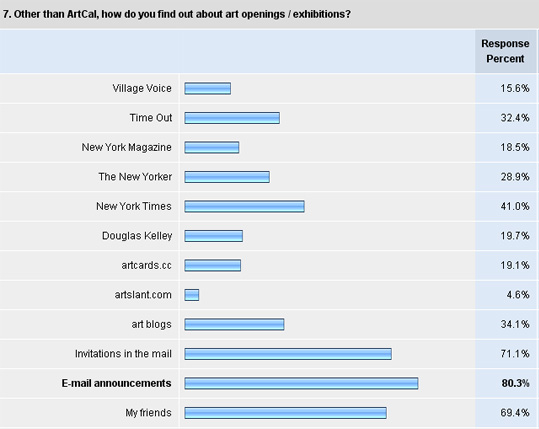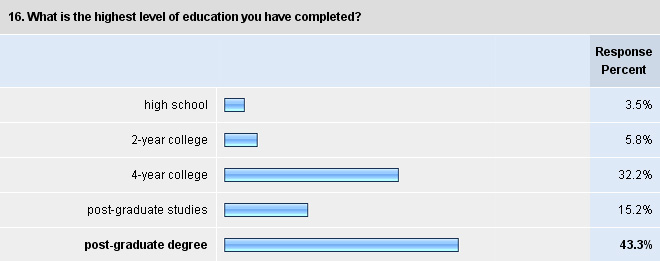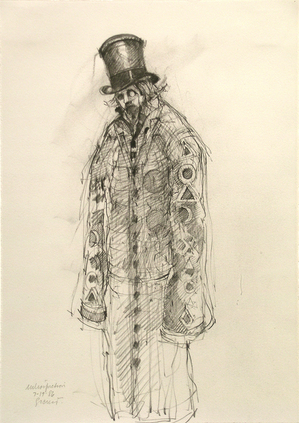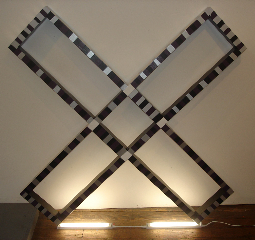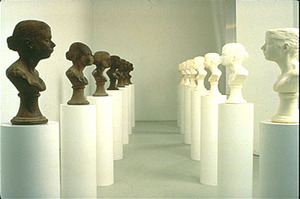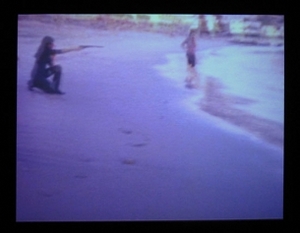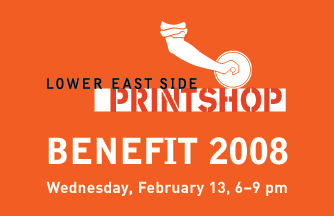This is an archive of the ArtCat Zine, 2007-2009. Please visit our new project, IDIOM.
February 2008
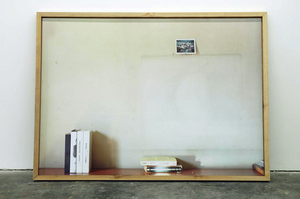
Impossible Archives
Part 2 of Tracing the Index
5:30pm Monday 3 March 2008
Kevorkian Center, NYU ground floor library
Sullivan Street 50 Washington Sq South
Archives are never about memory. This doesn't exclude the model of the archive of course, a potentially heterogrenous set of discrete constituting documents, from its instrumentalization into those national and pan-national memory industries which seek to consolidate demographics and populations into neatly delineated groups. Aleksandr Rodchenko, in the first half of the 20th century and 4 years after Lenin's death, for instance, proposed an archive as a monument to the revolutionary intellectual's legacy. Rather than a pictorial representation, an idealized likeness of the Chairman's visage, or a monolithic sculptural representation or abstraction, Rodchenko proposed that his memory be instituted as a kind of collection of selective trace documents — newspaper clippings, photographs, bits of manuscripts, and so on. Though the proposal was never officially carried out, it serves as good a reminder as any that the model of the archive may well be the modernist structure par excellence, similar to the collage in the disparate decontextualization and implied inclusionary politics of of its member elements. Indeed the affirmative or exclusionary archive has been utilized politically by both repressive and democratic political regimes to create historical narratives of sovereignty or a right to power, void traumatic histories, and counter critical or counter-hegemonic discourse by way of a horizontal organization of information — a discursive type of data structure. The archive of the impossible, that which evades casual organization or systemic documentation is the topic of the second roundtable at NYU of Tracing the Index, a four-part series of events organized by artists Chitra Ganesh and Mariam Ghani. We might imagine such an impossible archive as a solvent to its official counterpart, a collection of "unspeakable, unutterable, censored, undocumented disappeared or disappearing materials." To think about power in the 20th century it becomes impossible then to leave unconsidered the archive and its constitutive role in such matrices. It is to be expected also that this model should come to the attention of a critical contemporary art, necessary as it may be for any serious look cast on the history of that century. This is surely evinced by the past few years of intensive production of research, texts, exhibitions, and work on the archive in and on the periphery of contemporary art venues and distribution channels.
Participating in Monday's roundtable are artists Leslie Hewitt and Martha Wilson, historian Orit Halpern, writer Tal Halpern, professor of civil rights law Ramzi Kassem, and filmmaker Althea Wasow. The panelists will take on a discussion of "the role of artists and activists as archivists of unofficial or suppressed histories; the various manifestations of archive fever; and the relationships between witnesses, testimony, memory and archives."
Women in Experimental Film
Organized by M. M. Serra.
2pm and 4pm Saturday 1 March 2008
PS1 Contemporary Art Center - 22-25 Jackson Ave, Long Island City NY
This Saturday at PS1, the supporting film and video program of the recently opened exhibition WACK! Art and the Feminist Revolution, organized by Filmmakers Co-op director and filmmaker M. M. Serra, will screen in 2 parts. Works to be shown will include those by Peggy Ahwesh, Abigfail Child, Barbara Hammer, Morjorie Keller, Carolee Schneemann, and many others.
Here at ArtCal we seek out under recognized and under represented galleries and venues for contemporary art, specifically promoting the best emerging talent from those fields. Launched November 18th, 2004, what began as a listing service has seen significant growth over the last three and a half years. In 2005 we added images to the site's features, as well as RSS and iCal feeds. At the time, no other art listing website offered such tools, so I imagine the technology made heavy Internet users extraordinarily happy; as an active blogger it certainly made my life a lot easier. ArtCal continued in its Internet pioneering only a few months later hiring me as their listings editor - clearly a high point in their services! Since that time, we launched our newsletter on March 30th, 2006, our beautiful redesign on August 28th 2007, and most recently, ArtCal Zine, the flagship event and reviews publication which debuted on October 4th, 2007.
As ArtCal embarked on 2008 we asked our readers to tell us a little bit more about themselves, and are now ready announce our findings. Through the course of this survey we learned a number of interesting facts, not the least of which is that you all go to a lot of openings! Of those polled, only 5.2% said they didn't go to any receptions at all, where as 50% said they attended at least 1-3 each month, and 31% attend 5-10. 13.3% of you seem to have lives solely centering around openings and arrive at more than 10 throughout the course of 30 days.
ArtCal subscribers tell us that while they use a large number of publications to keep abreast of art openings, over 80% rely on email announcements to inform them of openings. Let this be a warning to all you who have blogs and assume you've told your friends merely by posting an event notice. It turns out email is still the most effective means of reaching an audience, and certainly a good reason to subscribe to our weekly newsletter if you haven't already. Nearly 43.3 percent of our audience have post graduate degrees, closely followed by those 32% with college degrees. We also suspect most of you are sexy, though SurveyMonkey.com has no scientific means of measuring this, except to tell us that 62.5% of our readers are between the ages of 25 and 44. Generally speaking that age bracket is hot, so congratulations everyone who hits that mark. Also congratulations are in order to the 42.8% of you who live in Manhattan. As a member of the 26.6% of Brooklyn dwellers, I look enviously upon you. Interestingly 11.6% of our readership lives outside the United States, which I think indicates an extremely invested demographic in the arts.
Speaking of which, it should not go unmentioned that an extremely high percentage of our readership are also collectors. Of those surveyed, over 49% said they planned to fill their homes with art. Given that 94% of our readers attend one or more openings per month, that we receive over 103,500 page views over that same time period, and that our audience is largely made up of upper middle class well educated readers, we are undoubtedly a desirable, and influential bunch. We are also growing. ArtCal newsletter subscribers hit 2000 in January, a number that continues to climb. Based on your feedback we will be adding a number of new features over the course of the next few months. Our aim as always, is to build upon and improve a service we're already really proud to offer all of you.
Exhibition talk with Boris Groys
Thinking in Loop: Three videos on iconoclasm, ritual and immortality
7pm Friday 29 February 2008
apexart - 291 Church St New York, NY
Theorist Boris Groys will present a talk this Friday at apexart in conjunction with his exhibition there of three videos completed in the past 5 years. Groys has for some years now been producing video essays as a component of his critical practice, employing the digital medium's lossless reproductive capacities to create visual narratives parallel with each video's performed text, producing bodies and images in motion ad infinitum. In this way Groys uses what he has suggested may be one of the most popular discursive forms of the new century to at once distribute and complicate his short texts, often engaging content for which the formal capacities of the medium are particularly suited. The same capacities the draw religious fundamentalists on the periphery of a globalizing world away from the written word and towards the mediated video image also draw Groys: the medium's potential for perfect reproduction and repetition.
Tom Secrest
Curated by Trenton Doyle Hancock
CUE Art Foundation - 511 W 25 St, New York NY
31 January - 8 March 2008
In my late teens, I regularly produced drawings of a tall, lean figure dressed in a tail suit and top hat. His facial features were usually obscured, but he glared at the viewer from under a heavy brow. I identified this character as a manifestation of my super ego, and I dubbed him The Observer. I produced at least a hundred such drawings in charcoal or soft-leaded pencil, working the darks into the paper until my fingers blackened. In hindsight, these drawings (and the imagination that spawned them) seem puerile and narcissistic, yet as I made my way around CUE Art Foundation's exhibition of drawings, paintings and prints by Louisiana-based artist Tom Secrest, I recalled that period of self-absorption almost wistfully.
The bulk of Secrest's recent works include a self portrait, either as the central focus or alongside the ghouls, skulls and angels that regularly appear in his compelling pictures. He depicts himself as a morose Shakespeare-type, with a prominent pate, wispy white mane, withdrawn eyes, and, sometimes, a top hat. The images are brooding and often aggressive, rendered with an obsessively graphic sensibility - the paintings, especially, are dominated by reds, and are most concerned with contour and geometry - and bear titles such as Three Sides of the Self, Introspection, Night Dreams, and even The Observer.
The exhibition is thoughtfully curated by the accomplished young artist Trenton Doyle Hancock, who wisely includes a sampling of Secrest's sketchbooks. The pages of these sketchbooks are crowded with heavily worked conte, pastel, charcoal or pencil drawings, and they provide us with a glimpse into what Secrest describes as his "compulsive image making." On a monitor in a corner of the gallery, Hancock displays a video interview with Secrest, as well as a tour of the artist's home studio. These inclusions are significant, emphasizing how thoroughly integrated Secrest's work and creative environment are. On screen, the sixty-five year old artist shuffles down a hallway hung floor to ceiling with artwork (most of it his) and curiosities: a big-eyed alien doll, top hats, masks, skulls and more. According to Hancock, every room is decorated in this fashion; he refers to the house as "a visionary environment." The overall effect is shrine-like, but Secrest's is a tomb-like shrine, dimly lit and silent, excepting the artist's intermittent cough.
An Evening with Sharon Hayes: On Politics and Desire
7pm Monday 25 February 2008
Titus Theatre 2
MoMA - 11 West 53 Street, New York NY
$10
Sharon Hayes will be at MoMA this Monday to present and talk about some of her recent work. The artist is known form working across mediums and venues, moving from institutional platforms to live street performance. Her work often engages rhetorical productions of meaning with the artist's performance of various texts culled from historical archives or anonymous sources. From the press release:
Hayes moves between multiple mediums—sound, performance, video, and installation—in an ongoing investigation of the intersections of history, politics, and speech. Her works draw on fictional narratives and interrogations of "real world" narratives, such as the rhetoric of Presidential addresses or the audiotapes made by Patty Hearst and the Symbionese Liberation Army. Hayes presents her most recent work, which focuses on the conditions of public speech and public opinion, and on the complicated relationship between politics and desire.
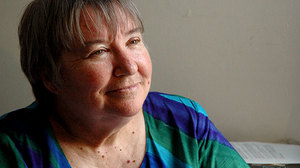
Glenn O'Brien's TV Party
7:30pm Friday 22 February 2008
New Museum - 235 Bowery, New York NY
$8
Unmasked: A Marathon of Artists' Videos and Films Contesting Systems of Rule
Saturday and Sunday, 23-24 February 2008
Various times
New Museum - 235 Bowery, New York NY
$museum admission (12)
Tomorrow night at the New Museum, non-commercial, art television variety show host Glenn O'Brien will present various selected clips form his well known New York public access show TV PARTY, active from 1978 through 1982. The show hosted many bands and musicians of note who would visit to perform or to be interviewed, not the least of which was David Byrne and Debbie Harry.
On Saturday and Sunday also at the New Museum, artist Carlos Motta and Museum as Hub Fellow Elise Youn present Unmasked, a screening of political film and video "contesting systems of rule." The screening includes works by artist Oliver Ressler, filmmaker Jim Finn, and many others. The program also includes Charged in the Name of Terror, a selection of short documentaries curated by Paul Chan that has appeared at Sundance Film Festival and other national venues. Charged... includes Chan's contemplative video portrait of Lynne Stewart, the longtime criminal defense attorney and activist who was charged with materially aiding terrorism by then Attorney General John Ashcroft in a precedent-setting case for her work represting suspected terrorist Sheik Omar Abdel-Rahma. Chan's program also includes filmmakers Mary Billyou and Annelisse Fifi's documentary of Mohamed Yousry, a naturalized US citizen, interpreter and translator whose life dramatically changed following his involvement in the trial of Sheik Omar Abdel-Rahma and the consequent prosecution of the translator for his involvement.
A Discussion with Rico Gatson
6pm Thursday 21 February 2008
Pocket Utopia - 1037 Flushing Ave, Brooklyn NY
Pocket Utopia will present a discussion this Thursday with artist Rico Gatson, whose work is currently on display at the gallery. The artist will talk about the situational prefix of "post-black," referring perhaps to the much discussed Freestyle exhibition at the Harlem Studio Museum in 2001, in which director Thelma Goldman and curator Christine Y. Kim provocatively situated the work of some 28 artists on view as "post-black" and of which Gatson was a part. The show was reviewed to mixed affect by many of New York's most visible popular art critics. Jerry Saltz wrote in the Village Voice:
If Freestyle works, it's because of what it does with its dual contexts. Rather than being a show of p.c. or unoriginal art about being black, Freestyle is stylistically free, hardcore without being hard-line. The diversity in this exhibition is the kind that's always been a hallmark of this museum: the aesthetic kind.
Peter Schjeldahl meanwhile writes in The New Yorker:
Freestyle,... presents the work of twenty-eight unheralded African-American artists, who, in their exploration of new realms of aesthetic pleasure and independent vision, plainly owe much to the politically convulsed nineties generation. This exhilarating show suggests that the ordeal of race in America may be verging on an upbeat phase that is without precedent.
The rhetorical momentum in these two responses to the exhibition is outwardly positive to be certain. But before the two critics excerpted here can feel comfortable getting behind this purportedly (post-)political exhibition, a sort of creeping apologia is performed. Both Schjeldahl and Saltz imply their wariness of "hard-line" political art or the politics of the "convulsive ninties," contrasted as they are to visual pleasure, originality, and freedom — although neither of the two texts reveal whether such an allergy to racial or political discourse in art, or even more generally a discursive or demystifying art, is a self-imposted aversion or perhaps a manifestation of a honed response strategy in the boxing-ring of their cultural framing. The two writers are enunciating here from privileged platforms of course in which a normative set of political and cultural inclinations is not only implied by their positions as high-profile and populist New York art critics, but necessitated for meaningful exchanges such as these to take place. Prejudices, politics, and taste combine to form the alloyed vessel that functions both to deliver these texts to an initiated public and affirm the cynical posture of much early 21st century art discourse and production by its constituting classes who would recant many of the hard-won battles of identity and gender politics since the peak and ebb of high-modernist abstraction.
Poet and critic Alan Gilbert revisits the Freestyle exhibition in his 2006 book Another Future: Poetry and Art in Postmodern Twilight in what he keenly characterizes as a kind of revealing marker of the popular sentiments in the contemporary art world, in both the show's curatorial framing and the mainstream critical response. Writing on Schjeldahl's text on the exhibition, Gilbert comments:
Peter Schjeldahl extolled [Freestyle] in The New Yorker, and the New York Times featured on the front page of the Sunday edition's Arts & Leisure section an extended piece by one of its staff art critics, Holland Cotter. Unsurprisingly, they, along with almost every other reviewer of the exhibition, seized on the phrase "post-black." Does it signal, as Schjeldahl seemed to believe, "that the ordeal of race in America may be verging on an upbeat phase that is without precedent"? In the face of criminally high incarceration rates of African American men, the structural economic and political (think Florida) disenfranchisement of African American communities, the beating and dragging death of James Byrd in Texas, riots in Cincinnati, more videotaped beatings of defenseless African American men by white police officers in the LAPD, and so on and on, Schjeldahl's account can at best be described as very, very optimistic. But this is arguing sociology versus aesthetics, an approach that is exactly the one many supporters of the Freestyle exhibiution hope has been officially left behind — both in the art created by minority artists and in the art world overall — now that the Studio Museum in Harlem has given the "post-black" category its institutional stamp of approval, and now that Golden, according to Schjeldahl, has seen the error of her earlier ways: "As a prominent curator at the Whitney throughout the nineties, Golden was a doyenne of multiculuturalism, pushing agendas that she has now magnanimously set aside" [Schjeldahl writes]. Yes, Schjeldahl's sigh of relief was meant to tbe that audible.
Television Delivers People
Whitney Museum of American Art - 945 Madison Ave New York, NY
12 December 2007 - 17 February 2008
You can tell a lot about a video exhibition by how the videos are shown. Those square grey cushions let you know to move on quickly while couches invite you to stick around for a while. Television Delivers People at the Whitney Museum, curated by Gary Carrion-Murayari, provides seating for about twelve, including only two benches directed toward the large screen on which most of the works loop in sequence. With over three hours of material, such an arrangement betrays a surprising lack of conviction in the show.
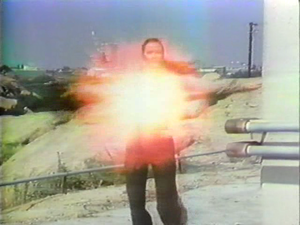
These issues of control and selectivity relate to the premise of the exhibition — videos examining how television and mass media entertainment exist to push an agenda of consumption, class politics, and the power of celebrity. The exhibition is named for a 1973 video by Richard Serra and Carlota Fay Schoolman. (Schoolman is clearly listed as a collaborator within the video itself, but the Whitney’s website and wall label attribute the piece to Serra alone. In an email response to my question about the discrepancy, the Whitney press office cited several archives that similarly list only Serra but offer no explanation for why Schoolman is no longer credited as a collaborator. Even if the reason for this change is benign, the Museum‘s lack of solid information is problematic.) In Serra and Schoolman’s video, included in the exhibition on one of three small monitors, statements about the function of entertainment as a means to "deliver" viewers to advertisers scroll up the screen while upbeat elevator music plays in the background. These straightforward and sometimes pointed comments seem almost quaint in the context of advertising today and the ever-blurring line between entertainment and brand promotion that are evident in viral marketing, cross marketing, and product placement.
Janine Antoni at SVA
6:30pm Tuesday 19 February 2008
Schoo of Visual Arts - 133/141 West 21 Street, room 101C
The School of Visual Arts will host a free public lecture tomorrow by artist Janine Antoni. Antoni is well known for a body of sculptural work the oftentimes bring the artist's corporeality to bear upon material, into processes that culminates in such work as Lick and Lather. The 1994 work features rows of life-sized busts of the artist, half sculpted in chocolate and the other half in white soap, that the artist has worn down over time by performances involving licking the former and bathing with the latter.
Unmonumental Online Rountable Discussion
3pm Saturday 16 February 2008
New Museum - 235 Bowery, New York NY
$museum admission (12)
Tomorrow at the New Museum, Rhizome's curator-at-large Marisa Olson will lead a conversation between four of the artists whose work is featured in the final cycle of the museum's Unmonumental exhibition: Michael Bell-Smith, William Boling, Kenneth Tin-Kin Hung, and Nina Katchadourian. Aligning itself with the themes of the online exhibition scheduled to become available on the web today, as well as being presented in the galleries of the museum, the talk will orbit around themes of appropriation, montage, and the kind of repurposing and contamination that happens in the complex ecologies of contemporary networked media.
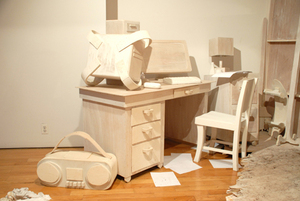
YARDSALE
Jade Townsend
31 January - 8 March 2008
Priska Jushcka - 547 W 27 St, New York NY
Jade Townsend creates installations and sculptures with a theatrical flare. His works are often like stage sets, constructed complete with props and scenery. What they seem to be lacking are the actors; which is, of course, where you, the viewer appear. Townsend invites you to wander across the stage and read the script that is everywhere in the work.
When it works, like Townsend's installation last year at Priska Juschka, and when the days fly by on their own, the elements he assembles line up like a well cast play. That work, which first confronted viewers with a prison-like façade, was broken open to reveal a white desk, chair, and small, comfortably suburban reading lamp. Above this desks was a window that looked out onto a miniature room, built in a forced perspective that ended in another window, peering just over the horizon of a model landscape. Outside again, and behind the brick room a barbed wire fence contained the miniature view, while behind the construction were several large trash barrels containing scrap wood and axes nestled in false flowers with the inscription "unlearn."
Taken all together the work suggests Foucauldian prison themes, the Abu Ghraib scandal, but also security, its limitations, and its inhibiting tendencies. More broadly, the work pointed to the impediments to altering one’s perspective and the need to question and even destroy perceived truths in favor of freedom of thought. The installation managed to feel not only topical, but also mined universal themes that transcended a narrow political interpretation.
Therefore, my expectations were high when I came to view Townsend’s new installation at Priska Juschka, YARDSALE. The title of this exhibition has an especially auspicious prescience when compared to the artist's previous efforts — whereas the last show title was written in a subtle lower case font and almost formed a complete sentence, YARDSALE is a single word delivered in heavy-handed capital letters.
Amy Granat and Emily Sundblad: 16mm films
8pm Saturday 16 February 2008
White Columns - 320 West 13th Street New York, NY
Amy Granat and Emily Sundblad have been collaboratively producing 16mm films for the past year and a half. This Saturday the two artists will screen several of these works at White Columns in Chelsea. Granat is known for her materialist approach to cinema, making modernist abstract films often by sabotaging her own shoots, over- or under-exposing the film, and directly manipulating the celluloid by hand. Sundblad, cofounder of artist's project and gallery Reena Spaulings Fine Art, has produced work across media as well as helped realize various immaterial and collective projects, not the least of which is the Reena Spaulings space and brand identity that has been used as a support structure for all varieties of interesting undertakings conducted by a constantly shifting cast of affiliates and collaborates since the project's 2004 inception. The films of the two often feature both women performing simple, repetitive actions in outdoor settings, exchanging the wind-up 16mm camera to take turns shooting. An exhibition of Sundblad and Granat's work is also currently on display in the Project space at White Columns through 16 February.
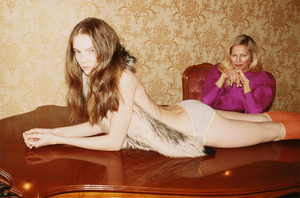
Ukraine
Juergen Teller
Lehmann Maupin Gallery - 540 W. 26 St, New York NY
7 February - 15 March 2008
Arriving at the Juergen Teller opening at Lehmann Maupin last week, I stared in horror at the huge crowd of people clamoring to get inside what seemed — and proved an impeccable assumption — a giant clothing ad disguised as an art exhibition. Luckily the crowd was smarter than I had anticipated. I pushed my way past the greedy looking eyes queuing up for their free Lufthansa sponsored sausage — because everything tastes better when it's free and corporate sponsorships allows one to justify this type of blind consumption. It's funny how popular this show was considering I didn't recognize anybody, despite their coy poses for the photographers who chased all the skinny c-listers with fur trimmed coats. The fur looked like cheap shit rabbit but at least she was tactful enough not to get her sausage bits all over the cases that held the photographs, unlike the other cow whose blatant disregard I secretly admired. Clearly someone decided that a photograph enclosed in what functions like a large table was both a practical and resourceful approach to exhibition strategy. I could not agree more. What was shocking however, was that Marc Jacobs had no hand in the show. If the patron saint of corporate sponsors heard my prayers, he would have sent copious MJ swag — or at least perfume samples. As a Board of Advisors "prime cut" member, even on the Phillips de Pury staff, we got diminutive plastic baggies that came in shiny shades shamrock and olive drab for us lucky female employees to choose from. The made-in-China tag was smaller than the MJ logo so everyone was thrilled. But for Juergen Teller — nothing, not even an appearance!
I airkissed my way to the door, finished my beer, complained about the traffic to the exit being worse than the L train at rush hour, and left with no lasting impressions except for the delightful image of one Ukrainian whore with a Third World boob job and a scar to show that was quite possibly worse than the one on Britney's vagina in that most memorable celebrity photo of 2007. Too bad Juergen didn't shoot that one. It could have been so much more poignant.
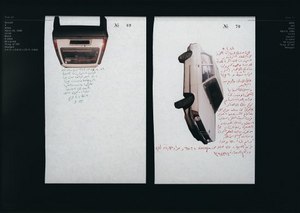
Gorging On Images: The Archive in 20th Century Photography
A Lecture by Sven Spieker
7:45pm Monday 11 February 2008
NYU Silver Center, Room 300
100 Washington Square East (entrance on Waverly Place)
In his 1986 essay The Body and the Archive, Allan Sekula asserts that the analytic methodologies of phrenology and physiognomy applied, in the latter half of the 19th century, to the photographic archive constructed the very parameters of the data they promised to analyze and interpret. This is to say, it is an archive's structure that makes possible, at its inception, the differentiation of the constituting sets, or bodies, of knowledge. The archival impulse in this sense, Sekula goes on, is reductive at its essence; criminal photography and the desire to create a sort of dictionary of photographs, phrenological types, and so on is a desire to index the world in a positivist, universal mathematical language — a geometric representation of forms. The model of the archive then may be a key structure to thinking about power and the 20th century, as Hal Foster has suggested the concept is instrumental to a Deleuzean understanding of societies of control in which, as Sekula also points out, the archive becomes a crucial apparatus for maintaining and exercising of modern power.
The archive similarly, consequent perhaps to its currency in the fields of the continental philosophy and critical studies of the past 40 years — as well as the apprehensible model it provides for describing bureaucratic systems of control or sites of media production, reproduction, and circulation — has become a voguish topic in contemporary art discourse. Practitioners, too, have taken on the form: from Rodchenko to Warhol to Broodthaers, the history of 20th century art is rife with examples of the cataloging, organizing, and preserving impulse of the archivist, or, artist as archivist. Tonight at NYU, Slavic studies scholar Sven Spieker will present a lecture entitled Gorging on Images: The Archive in Contemporary Photography, focusing on the "archival turn" in 20th century photographic production, as well as its remnants in contemporary art. From the press release:
The archive in contemporary photography—from Gerhard Richter to Susan Hiller and Tacita Dean—oscillates between the pathos of total inclusiveness and the specter of radical dispersion and discontinuity. In this lecture Spieker will trace this double orientation: first to the 19th-century (photo) archive with its rhetoric of preservation and identification, and second to what has been referred to as the early 20th century’s turn towards archival forms of organization as a result of the waning of the aesthetic of shock during the 1920s (photomontage). Using two seminal essays in the history of photography— Alexander Rodchenko’s ““Against the Synthetic Portrait, for the Snapshot” (1928) and Sigfried Kracauer’s“Photography” (1927)—he will demonstrate that this archival turn, whose impact on contemporary photographic practice is considerable, was not without its own internal fissures and contradictions.
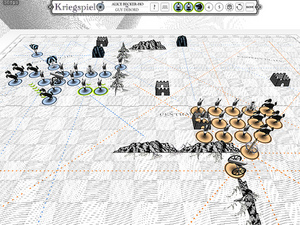
KRIEGSPIEL: Guy Debord's Game of War
Over The Opening: Radical Software Group
7-10pm Friday 8 February 2008
60 N. 6 St, Brooklyn NY
WAGMAG 2008 Benefit
7-9pm Friday 8 February 2008
Front Room Gallery - 147 Roebling St, Brooklyn NY
Artist collective MTAA open their studios this Friday evening for a monthly presentation of time-based work by invited artists and groups. New media ensemble Radical Software Group will be presenting KRIEGSPIEL: Guy Debord’s 1978 "Game of War", a new interactive videogame work that implements the eponymous game system Debord designed in the 50s, distributed in a limited-edition run in 1978, and finally commercially produced in 1987 with the help of his long-time friend and financier, French media mogul Gérard Lebovici. Nathan Heller has written a lengthy text in the Feb/March issue of BOOKFORUM about the relationship between the two men, and about Debord's hopes for the game, all on the occasion of the board game's re-release by Atlas Press. RSG re-implemented the abstruse rules of the game in Java and developed a table-top, three-dimensional interface for players to direct the action.
Also tomorrow is a benefit art show for WAGMAG, Williamsburg and Greenpoint's Monthly Art Guide. Admission to the even is free while tickets for artwork drawing are available for purchase — entitling the holder to take home one donated piece of art from a pool featuring works by Aron Naminwirth, William Powhida, Ian Pedigo, and many others. Along with these two events are 7 opening receptions at various Williamsburg sites open for extended hours for Williamsburg Every 2nd; more information is available online.
NOTE: Over the Opening shceduled for tonight in Williamsburg has been suspended today; our apologies for the short notice.
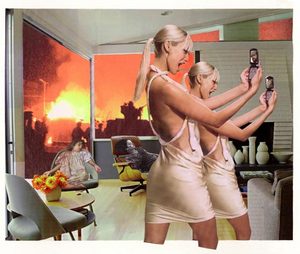
An Evening with Martha Rosler
Wollman Hall, Eugene Lang Building
65 West 11th Street, 5th floor (enter at 66 West 12th Street)
6pm Thursday 7 February 2008
A Tribute to Allan Kaprow
MoMA, Education and Research Building, Theatre 3
11 W 53 St, New York NY
Panel Discussion and Symposia
6:30pm Thursday 7 Februrary 2008
$10
Tonight Eugene Lang College of The New School opens an exhibition of Martha Rosler's work, with the artist scheduled to present a talk to coincide with the opening. On view will be several of Rosler's recent Iraq photomontages which update her Bringing The War Home series from the late 60s and early 70s. The photomontages are often composed of dense interiors that organize displaced visual elements from popular advertisements and photojournalism, literally bringing images from the war into the projected sanitized view of ideal American domestic life. Also on view will be GRINDCORE (2007), one of Rosler's new sound works exhibited last year at Location 1 in SoHo.
Also tonight, MoMA hosts a panel discussion and symposia on the late Allan Kaprow. A resurgence of interest in the artist's work was evident at last year's PERFORMA festival in New York, where André Lepecki, who is on the panel tonight, organized the remaking of Kaprow's 18 Happenings in 6 Acts. Moderated by Judith Rodenbeck of Sarah Lawrence College, the panel also features Letty Eisenhauer, of Manhattan Community College, artist Alison Knowles, and artist and former student of Kaprow's Robert Whitman. After the panel several material from the Museum's Art Library's Special Collections will be on view for audience members.
Open Sites: April 8, 1970
LIGHT IN BUFFALO
Molly Nesbit
6pm Thursday 7 February 2008
Institute of Fine Arts - #1 E. 78 St, New York NY
Art historian Molly Nesbit will present Open Sites: April 18 1970; Michel Foucault Lectures on Manet at Albright-Knox, the first in a cycle of three lectures beginning this thursday called LIGHT IN BUFFALO. The lectures constitute the 2008 Kirk Varnedoe Memorial Lectures at the IFA. Lectures are open to the public, but a reservation to [email protected] is required. From the press release:
Each lecture begins with a case study. Collectively they provide materials, tools, and examples with which to return the problem of art history to history. The fourth wall came off the theater of art history in the late sixties, just as it came off the revolution, the philosophical concept and the work of art. What is the physical reality of a thought ripped open? a lecture? a painting? Where does a work stand? And for how long? Who speaks for it? And for how long? These were the kinds of questions that erupted and interrupted. They provide the shadow for the light in Buffalo.
...At the beginning of the twentieth century, modern art's way of casting history involved projections outward, beyond the object, toward the future. The future came to replace history's long view. And yet before long this future found itself cut back and frozen, replaced by an endless present. Paradoxically, a return to history now can move us in turns both backward and forward. The friction could spark. Implicit is another question, a critical and political question: what would it mean for the work of art now to break open, to reinstall the long view forward and, at the same time, nonformally, empirically, ground it?
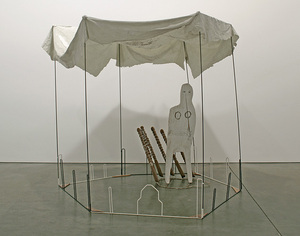
Matthew Ronay
Andrea Rosen Gallery - 525 W 24 St, New York NY
1 Februrary - 8 March 2008
Matthew Ronay is a good sculptor. He's not just making iconography in 3-D. He consistently tells a story about something larger than himself using our ideas about space and arranging objects to create interesting visual fields . I use Matthew Ronay's work when I am trying to explain the difference between a sculpture and an object to my students. He's definitely doing it right.
And when I teach really good students, I use Matthew Ronay's work to explain what happens when you do it a little too right, and do too little beyond that. His work tends to be very much of its sources. It's a little too Jessica Stockholder, and way too Paul McCarthy. It’s all blustery talk about getting fucked by big black men, all cock-and-balls, but cute cocks and balls. With a candy coated shell, downright conservative execution, and very little placed on the line. The note he tends to hit is hip and impersonal. The idea of a disaster.
Transgression Lite.
But there are no outwardly transgressions currently on view at Andrea Rosen. And very little MDF. No bright colors, "shocking" guttertalk titles, blood or buttholes. No grass or landscape or freeway. Nothing glossy, nothing cartoony, nothing silly, no scatology. Go to Andrea Rosen and see for yourself. There is sensitive primitivism devoid of schtick. Some rich material choices and an overwhelming sense of the artist's hand at work. It's still on the conservative side, but it's not cool. It's representations of shelter instead of speed. It's Africa meets Sukkot meets the feeling of being adrift at sea. It's romantic and it's earnest.
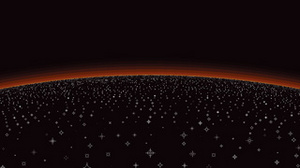
Michael Bell-Smith: Artist Talk + Screening
6:30pm Wednesday 6 February 2008
Electronic Arts Intermix - 535 W. 22 St, 5th Floor, New York NY
Michael Bell-Smith presents his first public New York artist's talk this Wednesday at EAI in Chelsea. Bell-Smith's interest in networked culture often informs his crafty, formal digital animations. At Foxy, for instance, Glitter Bend (2008), installed on a large flat-screen panel, presents a cosmic landscape populated by dozens of twinkling stars. The star field view is constituted not by any algorithmically rendered content but rather a composition of individual "hand-made" animated GIFs, a vernacular Internet media form whose small file size, seamless browser compatibility, and rewarding animation potential made the image format wildly popular in the early to mid 90s. The artist will speak about his work in relation to this sort of "net folk art" and other modes of contemporary media production and distribution along with screening several new and recent video works.
Lower East Side Printshop Benefit Auction and Sale
6-9pm Wednesday 13 February 2008
306 W. 37th St, 6th Fl.
The Lower East Side Printshop will celebrate it's 40th anniversary this year and host its annual benefit on Wednesday 13 Februrary. ArtCal is a sponsor of the event, and tickets to the benefit are now available online. The complete auction and benefit sale proceeds will go to support the Printshop's various artist residency programs. Works slated for auction will include those by Kiki Smith, Will Cotton, Ann Craven, Matthew Day Jackson, Ryan McGinness, and many others. The benefit sale, meanwhile, will include an even greater number of donated artworks by friends of the Printshop.
ZINE
HOME
TIPS / COMMENTS
CATEGORIES
CONTRIBUTORS
- Greg Afinogenov
- B. Blagojevic
- Adda Birnir
- Susannah Edelbaum
- Julie Fishkin
- Paddy Johnson
- Jessica Loudis
- Christopher Reiger
- Andrew Robinson
- Peter J. Russo
- Blythe Sheldon
- S.C.Squibb
- Hrag Vartanian

